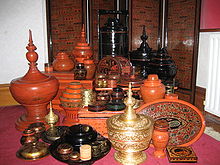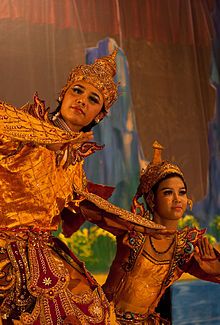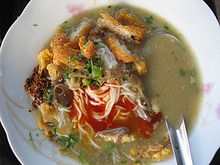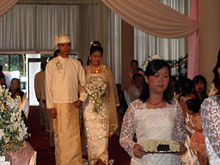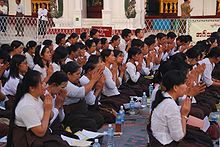- Culture of Burma
-
The culture of Burma (or Myanmar) has been heavily influenced by Buddhism and the Mon people. Its neighbours, particularly China and Thailand have made major contributions to Burmese culture. In more recent times, British colonial rule and westernisation have influenced aspects of Burmese culture, including language and education.
Contents
Arts
A collection of Burmese lacquerware from Bagan
Historically, Burmese art was based on Buddhist or Hindu cosmology and myths. There are several regional styles of Buddha images, each with certain distinctive characteristics. For example, the Mandalay style, which developed in the late 1800s, consists of an oval-shaped Buddha with realistic features, including naturally curved eyebrows, smaller but still prominent ears, and a draping robe.[1] There are 10 traditional arts, called pan sè myo (ပန်းဆယ်မျိုး), listed as follows:[2]
- Blacksmith (ပန်းပဲ ba-bè)
- Woodcarving (ပန်းပု ba-bu)
- Goldsmith (ပန်းထိမ် ba-dein)
- Stucco relief (ပန်းတော့ pandaw)
- Masonry (ပန်းရန် pa-yan)
- Stone carving (ပန်းတမော့ pantamaw)
- Turnery (ပန်းပွတ် panbut)
- Painting (ပန်းချီ bagyi)
- Lacquerware (ပန်းယွန်း panyun)
- Bronze casting (ပန်းတဉ်း badin)
In addition to the traditional arts are silk weaving, pottery, tapestry making, gemstone engraving, and gold leaf making. Temple architecture is typically of brick and stucco, and pagodas are often covered with layers of gold leaf while monasteries tend to be built of wood (although monasteries in cities are more likely to be built of modern materials). A very common roofing style in Burmese architecture is called pyatthat (ပြာသာဒ်), which is a multi-tiered and spired roof.
Literature
Main article: Literature of BurmaBurmese literature has been greatly influenced by Buddhism, notably the Jataka Tales. Since orthodox Buddhism prohibited fiction[citation needed], many historical works are nonfiction. However, British colonisation introduced many genres of fiction which have become extremely popular today. Poetry is a prominent feature and there are several forms unique to Burmese literature.By1976, only 411 titles were published annually, compared to 1882, when 445 titles were published. Various factors, especially the lengthened bureaucratic process to obtain printing permits, censorship, and increasing economic hardship of consumers because of the socialist economic schemes, contributed to the decline of Burmese literary output.
Popular novels are have similar themes, often involving adventure, espionage, detective work, and romance. Many writers also translate Western novels, especially those of Arthur Hailey and Harold Robbins. The flourishing translation sector is the result of the Burmese government, which did not sign the Universal Copyright Convention Agreement, which would have forced Burmese writers to pay royalties to the original writers.
Short stories, often published in magazines, also enjoy tremendous popularity. They often deal with everyday life and have political messages (such as subtle criticisms of the capitalist system), partly because unlike novels, short stories are not censored by the Press Scrutiny Board. Poetry is also a popular genre today, as it was during the monarchical times, but unlike novels and other works, which use literary Burmese, may use the vernacular, instead of literary Burmese. This reform movement is led by left-leaning writers who believe laymen's language (the vernacular and colloquial form of Burmese) ought to be used instead of formal Burmese in literature.
One of the greatest female writers of the Post-colonial period is Journal Kyaw Ma Ma Lay. Khin Myo Chit was another important writer, who wrote, among her works, The 13-Carat Diamond (1955), which was translated into many languages. The journalist Ludu U Hla was the author of numerous volumes of ethnic minority folklore, novels about inmates in U Nu-era jails, and biographies of people working in different occupations. The Prime Minister U Nu himself wrote several politically oriented plays and novels.
Other prolific writers of the post-colonial era include Thein Pe Myint (and his The Ocean Traveller and the Pearl Queen, considered a Burmese classic), Mya Than Tint (known for his translations of Western classics like War and Peace), Thawda Swe and Myat Htun. Distinguished women writers, who have also been an ever-present force in Burmese literary history, include Kyi Aye, Khin Hnin Yu, and San San Nweh. Burmese Historians: Ba Shin, Than Tun, Thant Myint-U, Htin Aung, Sao Saimong, Myoma Myint Kywe,and San C. Po were famous in Burma.
Dance
Main article: Dance in BurmaDance in Burma can be divided into dramatic, folk and village, and nat dances, each having distinct characteristics. Although Burmese dance has been influenced by the dance traditions of its neighbors, in particular Thailand (yodaya aka), it retains unique qualities that distinguish it from other regional styles, including angular, fast-paced and energetic movements and emphasis on pose, not movement.[3]
Music
Main article: Music of BurmaVarious types of Burmese music use an array of traditional musical instruments, assembled in an orchestra known as hsaing waing[4] which the Burmese saing saya Kyaw Kyaw Naing has made more widely known in the West. Traditional folk music is atypical in Southeast Asian music, as it is characterized by sudden shifts in rhythm and melody as well as change in texture and timbre.[5] An instrument unique to Burma is the saung-gauk,[4] an arched harp that can be traced to pre-Hittite times. Classical traditions of Burmese music are found in the Mahagita, an extensive collection of classical songs and are typically divided into indoor and outdoor ensembles. These songs tend to be about various legends in Pali and subsequently in Burmese intermingled with Pali, related to religion or the power and glory of monarchs, and then the natural beauty of the land, forests and the seasons, eventually feminine beauty, love, passion and longing, in addition to folk music sung in the paddy fields. Pop music, however, dominates the music of Burma today, both adopted and homegrown.
Customs
The "traditional" Burmese greeting is mingalaba (မင်္ဂလာပါ, from Pali mangala and roughly translated as 'auspiciousness to you'), which is relatively recent as the custom started in schools in the 1960s effectively replacing the English "Good morning/afternoon, teacher" in the newly nationalised missionary schools; it is also considered formal and used in formal situations.[6] Greetings such as "Have you eaten?" (ထမင်းစားပြီးပြီလာ Htamin sa pi bi la) and "How are you?" (နေကောင်းလာ Nei kaung la) are still more commonly used as they have always been. "Hello" is also a popular greeting nowadays, whereas it used to be confined to answering the phone.
Dress
The traditional garment of the Burmese is called longyi (လုံချည်), a sarong worn by both men and women. In formal occasions, Bamar men wear a collarless jacket (တိုက်ပုံအင်္ကျီ) over a mandarin collared shirt (sometimes donning a turban called gaung baung), while Bamar women wear a blouse buttoned at the front, called yinzi (ရင်စေ့) or to the side, called yinbon (ရင်ဖုံး), and a shawl. In urban areas, skirts and pants are becoming more common, particularly among the young.
During the British colonial era, Burmese nationalists associated traditional clothing, in particular Yaw longyi (ယောလုံချည်), a type of longyi from the Yaw region, and pinni taikpon (ပင်နီတိုက်ပုံအင်္ကျီ), a fawn-colored collarless jacket, with anti-colonialism and nationalist sentiment, because of a clampdown in the 1920s over increasing dissent.[7] Wearing "traditional" clothing was seen as a mode of passive resistance among the Burmese.[7] However, British rule nonetheless influenced hair fashion and clothing. Cropped short hair, called bo ke (ဗိုလ်ကေ) replaced long hair as the norm among Burmese men.[8] Similarly, women began wearing hairstyles like amauk (အမောက်), consisting of crested bangs curled at the top, with the traditional hair bun (ဆံထုံး).[8] The female sarong (htamein) became shorter, no longer extending to the feet, but to the ankles, and the length of the sarong's top decreased to reveal more waistline.[8] This period also saw the introduction of a sheer muslin blouse for women, revealing a corset-like lace bodice called za bawli (ဇာဘော်လီ).
Speech
The Burmese language is very age-oriented. The use of honorifics before personal names is the norm, and it is considered rude to call a person just by their name without the honorific unless they are known from childhood or youth or in the case of a younger underling. Young males are addressed as Maung or Ko (lit. brother), and older or senior men as U (lit. uncle). Likewise, young females are addressed as Ma (lit. sister), and older or senior women as Daw (lit. aunt), regardless of their marital status. 'Aunty' or 'Uncle' is commonly used as well today. The first and second person pronouns vary depending on whom one is speaking to and are age-dependent. Elders are spoken to in a more respectful manner and a special vocabulary exists for speaking to Buddhist monks.[4]
Manners
Burmese society operates on ana (အားနာမှု), a characteristic or feeling that has no English equivalent. It is characterized by a hesitation, reluctance or avoidance, to perform an action based on the fear that it will offend someone or cause someone to lose face, or become embarrassed.[9] Also, there is the concept of hpon (ဘုန်း; from Sanskrit bhaga), which translates to "power". It is used as an explanation for the varying degrees of ethnic, socioeconomic, and gender differences between people in a society.[3] Hpon refers to the cumulative result of past deeds, an idea that power or social position comes from merit earned in previous lives.[3] This idea is used to justify the prevalent view that women are less equal than men, who are considered to have more hpon.
Age is still considered synonymous with experience and wisdom, hence venerated. Parents and teachers are second only to the Three Jewels (ရတနာသုံးပါး yadana thoun ba), together making up the Five Boundless Beneficence (အနန္တငါးပါး ananda nga ba), and are paid obeisance (called gadaw) at special times of the year such as Thingyan, beginning and end of lent, and usually parents before one leaves on a journey. Elders are served first at meals, and in their absence a spoonful of rice is put aside first in the pot as a token of respect (ဦးချ u cha) before serving the meal. Young people would avoid sitting on a higher level than the elders or passing in front of them unless unavoidable when they would tread softly and with a slight bow. Things would be passed to the elders using both hands together. Men may cross their legs sitting on a chair or a mat but women generally would not.
Children are taught from young 'to venerate one's elders, to respect one's peers, and to be kind to the young and weak' (ကြီးသူကိုရိုသေ၊ ရွယ်သူကိုလေးစား၊ ငယ်သူကိုသနား။ kyeethu go yothei, ywedu go layza, ngethu go thana). Parents are believed to be solely responsible for their children's behaviour as reflected by the expressions: mi ma hsonma, hpa ma hsonma (မိမဆုံးမ ဖမဆုံးမ undisciplined either by mother or by father) and ami youk tau hnoukkyan, ahpa youk tau ko amu-aya kyan (bad language from bad mother, bad body-language from bad father). Saying "thank you" however is not Burmese custom between friends and within the family.
It is considered rude to touch a person's head, because it is the "highest" point of the body. It is also considered taboo to touch another's feet, but worse still to point with the foot or sit with feet pointing at someone older, because the feet are considered the lowest. Also, pointing a finger at Buddha images is considered blasphemous, although this custom has slowly eroded. Shoes are always taken off upon entering homes, monasteries and pagoda compounds. A custom of the Burmese is to perambulate clockwise (လက်ယာရစ် let ya yit) around a pagoda, not counterclockwise (လက်ဝဲရစ် let wè yit).
Physical demonstrations of affection in public are common between friends of the same gender or between members of the family, but seldom seen between lovers. It is thus common to see friends walking together holding hands or with arms round each other, but couples rarely do so, except in major cities.
Cuisine
Mohinga, rice noodles in fish soup, is widely considered to be Burma's national dish. Main article: Cuisine of Burma
Main article: Cuisine of BurmaBurmese cuisine has been influenced by Indian, Chinese and Thai cuisines as well as domestic ethnic cuisines. It is not widely known throughout the world and can be characterized as having a mildly spicy taste, with a limited use of spices. A typical Burmese meal consists of several meat curries, a soup, steamed rice and fermented sauce of preserved fish, along with vegetables for dipping. Condiments like balachaung, Indian-style pickles and pickled vegetables are commonly served alongside the course. Although fish sauce and shrimp paste are commonly used ingredients, as in other Southeast Asian cuisines, Burmese cuisine also makes extensive use of chickpeas, lentils and tamarind (used to add a sour flavour, unlike other regional cuisines that tend to use lime juice or vinegar).[10] Ethnic cuisines, in particular Shan cuisine, are also prominently found throughout Burma, as are Indian and Chinese dishes, particularly in urban areas. The de facto national dish is mohinga (မုန့်ဟင်းခါး), rice noodles in a rich fish soup. Salads (အသုပ်), especially laphet thoke, which is a salad of pickled tea leaves, are also popular dishes. The Burmese traditionally eat with their fingers, although the usage of Western utensils and chopsticks have become more widespread, especially in towns and cities. Aside from rice, Indian breads like paratha and naan as well as noodles are also commonly eaten with dishes.
Marriage
Traditional Burmese folklore considers love to be destiny, as the Hindu god Brahma writes one's destiny in love on a child's brow when he or she is six days old, called na hpuza (နဖူးစာ, lit. "destiny on the forehead"). A Burmese wedding can be religious or secular and extravagant or simple. Traditionally, a marriage is recognized with or without a ceremony when the man's longyi (sarong) is seen hanging from a rail of the house or if the couple eats from the same plate. Dowries are typically unheard of, and arranged marriage is not a custom of the Burmese. Weddings are traditionally avoided during the Buddhist lent, which lasts three months from July to October.[11]
However, many Burmese couples opt for more extravagant affairs. Generally speaking, Buddhist monks are not present to conduct the wedding and solemnize the marriage, as they are forbidden to officiate a marriage. However, they may be invited to bless the newly wed couple. A more extravagant wedding requires months of preparation, including consultation with an astrologer in choosing the most auspicious time and setting of the event. Also, a master of ceremonies, typically a brahmin, is hired to preside over the ceremony. The bride and groom sit on cushions next to each other. At the beginning of the wedding, the Brahmin blows a conch shell to commence the ceremony and joins the palms of the couple, wraps them in white cloth, and dips the joined palms in a silver bowl. The Burmese word "to marry" is let htat (လက်ထပ်), which literally means "to join palms together". After chanting a few Sanskrit mantras, the brahmin takes the couple's joined palms out of the bowl and blows the conch shell to end the ceremony.[12] Afterward, entertainers perform, and the wedding is ended with a speech by a guest of higher social standing. Wedding receptions at a hotel, serving tea and ice cream, are common in urban areas.
Funerals
Burmese funerals typically last a week, with the body traditionally buried or cremated on the third day. Burial is common, but cremation is also practiced[clarification needed] orthodox Buddhists and monks in Burma. A coin, called gadaw ga (ကန်တော့ခ) is placed in the mouth of the deceased person, to pay a "ferry toll" for crossing death.[13] Before the actual interment of the body, an offering of turmeric-coated rice is given to appease the bhummazo (ဘုမ္မစိုး), the guardian deity of the earth.[14] During the actual funeral, gifts in the form of paper fans containing the deceased person's name, as well as Buddhist scriptures relating to the impermanence of life (anicca) and samsara are distributed to all attendees.[15] In urban areas, flower wreaths and florals are typically given at a funeral, as well as money, for less well-to-do families. However, in villages, more practical gifts such as food items are given to the grieving family. For seven days, the windows and doors of the house in which the person died may be left open, in order to let the deceased person's consciousness or "spirit", called leippya (လိပ်ပြာ, lit. "butterfly") leave the home, and a vigil may be kept at nighttime. On the seventh day, called yet le (ရက်လည်), a meal is offered to monks, who in turn recite blessings, protective parittas and transfer merit to the deceased, concluded with a Buddhist water libation ceremony.[14]
Religion
Main article: Religion in BurmaBurma is a predominantly Theravada Buddhist country. Buddhism reached Burma around the beginning of the Christian era, mingling with Hinduism (also imported from India) and indigenous animism. The Pyu and Mon kingdoms of the first millennium were Buddhist, but the early Bamar peoples were animists. According to traditional history, King Anawrahta of Bagan adopted Buddhism in 1056 and went to war with the Mon kingdom of Thaton in the south of the country in order to obtain the Buddhist Canon and learned monks. The religious tradition created at this time, and which continues to the present day, is a syncretalist mix of what might be termed 'pure' Buddhism (of the Theravada school) with deep-rooted elements of the original animism or nat worship[4][16] and even strands of Hinduism and the Mahayana tradition of northern India.
Islam reached Burma at approximately the same time, but never gained a foothold outside the geographically isolated seaboard running from modern-day Bangladesh southward to Irrawaddy Delta (modern Rakhine State, formerly Arakan, an independent kingdom until the eighteenth century). The colonial period saw a huge influx of Muslim (and Hindu) Indians into Yangon and other cities, and the majority of Yangon's many mosques and temples owe their origins to these immigrants.
 Saint Mary's Cathedral in Downtown Yangon is the largest Roman Catholic cathedral in Burma.
Saint Mary's Cathedral in Downtown Yangon is the largest Roman Catholic cathedral in Burma.
Christianity was brought to Burma by European missionaries in the 1800s. It made little if any headway among Buddhists, but has been widely adopted by non-Buddhists such as the Chin, Karen, and Kachin. The Roman Catholic Church, Myanmar Baptist Convention and the Assemblies of God of Burma are the largest Christian denominations in Burma. Burma is home to the second largest population of Baptists in the world, after the United States, the result of American missionary work.
The Chinese contribution to Burma's religious mix has been slight, but several traditional Chinese temples were established in Yangon and other large cities in the nineteenth century when large-scale Chinese migration was encouraged by the British. Since approximately 1990 this migration has resumed in huge numbers, but the modern Chinese immigrants seem to have little interest in religion. Some more isolated indigenous peoples in the more inaccessible parts of the country still follow traditional animism.
Burma has nominal guarantees of freedom of religious expression, although religious minorities (Christians and Muslims), particularly those in the countryside are subject to discrimination. Sporadic riots between Burmese Buddhists and Burmese Muslims are not uncommon, and tensions between the two religious groups are high, particularly in major cities. In 2001, after the Taliban's destruction of the Buddhas of Bamiyan, religiously motivated riots broke out between Buddhists and Muslims across major cities in Burma, including Sittwe, Pyay, Taungoo and Bago.[17] The current regime's nationalistic policy of Bama san-gyin, which considers Buddhism a key element of Burmese-ness, does provide a systemic bias in favour of Buddhists in terms of preferment in the armed forces and other State structures.[18]
Pagodas and monasteries
Aspects of Burmese culture are most apparent in religious sites. The country has been called the "Land of Pagodas" as the landscape is dominated by Buddhist pagodas or stupas. The four most important Burmese Buddhist pilgrimage sites are Shwedagon Pagoda in Yangon, Mahamuni Buddha in Mandalay, Kyaiktiyo Pagoda in Mon State, and Bagan, an ancient capital by the Ayeyarwaddy River where thousands of stupas and temples have stood for nearly a millennium in various states of repair .
Pagodas are known by their Pali terms zedi (စေတီ) or pahto (ပုထိုး), but are also commonly called hpaya (ဘုရား) which is synonymous with "Buddha". Monasteries are known as hpongyi kyaung (ဘုန်းကြီးကျောင်း), hpongyi meaning monk, and since they have traditionally been places of learning where village children are taught how to read and write including and more importantly Pali, the language of the Buddhist scriptures, school also came to be called kyaung (ကျောင်း) in the Burmese language.
Traditional festivals
There are twelve months in the traditional Burmese calendar and twelve corresponding festivals.[19] Most of the festivals are related to Burmese Buddhism and in any town or village the local paya pwè (the pagoda festival) is the most important one.[4]
The most well-known festival is Thingyan, a four-day celebration of the coming lunar new year. This festival is held prior to the Burmese New Year (first day of Tagu, around 17 April). Similar to other Southeast Asian new year festivals (e.g. Songkran), people splash water on one another. However, Thingyan has religious significance, marking the days in which Buddhists are expected to observe the Eight Precepts of Buddhism.[20]
Sports
The most popular sport in Burma is football (soccer).[16] Chinlone is an indigenous sport that utilises a rattan ball and is played using mainly the feet and the knees, but the head and also the arms may be used except the hands.[4][21] Burmese kickboxing called Lethwei is popular and tournaments may be seen at pagoda festivals. A form of Burmese martial arts derived from the Shan called thaing, divided into bando (unarmed combat) and banshay (armed combat), rather similar to Chinese Kung fu, is also practised. Of the twelve seasonal festivals, regattas are held in the month of Tawthalin (August/September), and equestrian events were held by the royal army in the time of the Burmese kings in the month of Pyatho (December/January).[19] During British rule, the game of cricket was played by the ruling British, with the Burma national cricket team playing a number of first-class matches. The team exists today, although no longer of first-class quality and is an Affiliate member of the International Cricket Council.
National holidays
Main article: Public holidays in BurmaDate (2010) English name Burmese name Remarks 4 January Independence Day လွတ်လပ်ရေးနေ့ Lut lat yay nei marks independence from British Empire in 1948 12 February Union Day ပြည်တောင်စုနေ့ Pyidaungzu nei anniversary of the Panglong Agreement in 1947 26 February Full Moon of Tabaung တပေါင်းလပြည့်နေ့ Tabaung la pyei nei Tabaung pwè Pagoda Festivals 2 March Peasants Day တောင်သူလယ်သမားနေ့ Taungthu lèthama nei anniversary of Ne Win's coup 27 March Tatmadaw Day တော်လှန်ရေးနေ့ Taw hlan yei nei formerly Resistance Day (against the Japanese occupation in 1945) 13 - 16 April Water Festival သင်္ကြန် Thingyan celebrates and brings in the Burmese New Year 17–21 April Burmese New Year နှစ်ဆန်းတစ်ရက်နေ့ Hnit hsan ta yet nei marks the New Year of the Burmese calendar 1 May Labour Day အလုပ်သမားနေ့ a louk thama nei 8 May Full Moon of Kason ကဆုန်လပြည့်ဗုဒ္ဓနေ့ Kason la pyei Boda nei anniversary of the birth, enlightenment and death of the Buddha celebrated by watering the Bodhi tree 19 July Martyrs' Day အာဇာနည်နေ့ Azani nei commemorates the assassination of Aung San and several other cabinet members in 1947 26 July Beginning of Buddhist Lent ဝါဆိုလပြည့်နေ့ Waso la pyei nei 23 October End of Buddhist Lent သီတင်းကျွတ် Thadingyut Festival of Lights Oct - Nov Diwali ဒေဝါလီနေ့ Deiwali nei 21 November Tazaungdaing Festival တန်ဆောင်မုန်းလပြည့်နေ့ Tazaungmon la pyei nei Festival of Flying Lanterns/Hot-air Balloons 1 December National Day အမျိုးသားနေ့ Amyotha nei anniversary of the first university students strike in 1920 25 December Christmas ခရစ္စမတ်နေ့ Hkarissamat nei Dec - Jan Eid ul-Adha အိဒ်နေ့ Id nei a festival of sacrifice at the end of Hajj (annual pilgrimage to Mecca) 5 January 2011 Kayin (Karen) New Year ကရင်နှစ်သစ်ကူး Kayin hnithiku celebrates the New Year of the Karen people See also
- Burmese mythology
- Burmese names
- Mythical creatures in Burmese folklore
- University of Culture, Mandalay
- University of Culture, Yangon
References
- ^ "Buddha Images from Burma, Part I". L'Asie Exotique. http://www.lasieexotique.com/mag_buddha_I/mag_buddha_I.html. Retrieved 2007-07-30.
- ^ "Myanmar Traditional Arts". http://myanmartravelinformation.com/mti-myanmar-arts/index.htm.
- ^ a b c Marshall Cavendish Publishing, ed (2007). World and Its Peoples: Eastern and Southern Asia. Marshall Cavendish. pp. 630–640. ISBN 9780761476313.
- ^ a b c d e f Shway Yoe (Sir James George Scott) 1882. The Burman - His Life and Notions. New York: The Norton Library 1963. pp. 317–318, 231–242, 211–216, 376–378, 407–408.
- ^ Miller, Terry E.; Sean Williams (2008). The Garland handbook of Southeast Asian music. Routledge. pp. 17. ISBN 0415960754.
- ^ Houtman, Gustaaf (1999). Mental culture in Burmese crisis politics. ILCAA. p. 130. ISBN 4872977483.
- ^ a b Edwards, Penny (2008). "Nationalism by design. The politics of dress in British Burma". IIAS Newsletter (International Institute for Asian Studies) (46): 11. http://www.iias.nl/nl/46/IIAS_NL46_11.pdf.
- ^ a b c Ikeya, Chie (2008). "The Modern Burmese Woman and the Politics of Fashion in Colonial Burma". The Journal of Asian Studies (Cambridge University Press) 67: 1277–1308. doi:10.1017/S0021911808001782. http://journals.cambridge.org/action/displayAbstract?fromPage=online&aid=2541936.
- ^ http://www.myanmar.gov.mm/Perspective/persp2001/1-2001/nar.htm
- ^ Meyer, Arthur; Jon M. Vann (2003). The Appetizer Atlas: A World of Small Bites. John Wiley and Sons. pp. 274–276. ISBN 9780471411024.
- ^ Aye Sapay Phyu; Yadana Htun (29 October 2007). "Yangon hotels prepare for post-Lent wedding rush". Myanmar Times. http://www.mmtimes.com/no390/t001.htm. Retrieved 22 August 2011.
- ^ Win, Nyunt (2006-10-30). "Traditional weddings victim of convenience". The Myanmar Times.
- ^ Scott, James George (1882). The Burman, His Life and Notions. pp. 590–594. ISBN 9781115231954. http://www.burmalibrary.org/docs09/burmanhislife¬ions-scott-2.pdf. Retrieved 2010-09-19.
- ^ a b Spiro, Melford E. (1982). Buddhism and Society: a great tradition and its Burmese vicissitudes (2nd ed.). London: University of California Press. pp. 248–254. ISBN 9780520046726.
- ^ Min Zin. "Burmese Buddhism and its Impact on Social Change". Virginia Review of Asian Studies: 2. http://www.virginiareviewofasianstudies.com/files/archives/2003/Burmese_zin.pdf.
- ^ a b Andrew Marshall (2002). The Trouser People. Washington DC: Counterpoint. pp. 61–63, 32–33, 11113.
- ^ "Crackdown on Burmese Muslims". Human Rights Watch. http://hrw.org/backgrounder/asia/burma-bck1.htm. Retrieved 2007-07-30.
- ^ "Burma Human Rights Yearbook 2006" (PDF). National Coalition Government of the Union of Burma. pp. 523–550. Archived from the original on 2007-09-28. http://web.archive.org/web/20070928070830/http://www.ncgub.net/mediagallery/download.php?mid=20070702190012811. Retrieved 2007-08-06.
- ^ a b "Introduction of Myanma Festivals". Yangon City Development Council. http://www.yangoncity.com.mm/1.About_ygn/9.festival/default.asp. Retrieved 2006-11-14.
- ^ "The Eight Precepts". http://www.accesstoinsight.org/ptf/dhamma/sila/atthasila.html.
- ^ "Chinlon - Myanmar Traditional Sport". http://myanmartravelinformation.com/mti-myanmar-culture/chinlon.htm.
External links
- Burmese Literature inc. audio
- An Introduction to Burmese Sculpture
- The Exquisite Art of Wood Carving by Pyi Phone Myint
- Burmese Festivals
- Mystic Ball - the Movie (Chinlon)
- Social and Arts Trend Changes in Burma BBC Burmese Highlights: Year-end Specials 2006
- Living and Learning English in Mandalay
Architecture · Visual art · Cinema · Clothing and dress · Cuisine · Dance · Folklore · Literature · Marionette · Media · Music · Public holidays · ReligionCulture of Southeast Asia Culture of Asia Sovereign
states- Afghanistan
- Armenia
- Azerbaijan
- Bahrain
- Bangladesh
- Bhutan
- Brunei
- Burma (Myanmar)
- Cambodia
- People's Republic of China
- Cyprus
- East Timor (Timor-Leste)
- Egypt
- Georgia
- India
- Indonesia
- Iran
- Iraq
- Israel
- Japan
- Jordan
- Kazakhstan
- North Korea
- South Korea
- Kuwait
- Kyrgyzstan
- Laos
- Lebanon
- Malaysia
- Maldives
- Mongolia
- Nepal
- Oman
- Pakistan
- Philippines
- Qatar
- Russia
- Saudi Arabia
- Singapore
- Sri Lanka
- Syria
- Tajikistan
- Thailand
- Turkey
- Turkmenistan
- United Arab Emirates
- Uzbekistan
- Vietnam
- Yemen
States with limited
recognition- Abkhazia
- Nagorno-Karabakh
- Northern Cyprus
- Palestine
- Republic of China (Taiwan)
- South Ossetia
Dependencies and
other territoriesCategories:- Burmese culture
Wikimedia Foundation. 2010.

